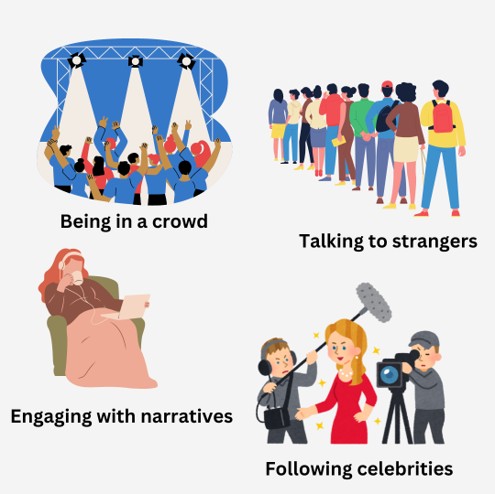
Dr. Gabriel’s research in this area starts with the assumption that the human need for social connection is strong, subtle, and sneaky. That means that people can fill it in lots of ways – sometimes without even know it! We have looked at all kinds of ways of filling belongingness needs, including watching TV, reading books, and eating comfort foods.
All PDFs are available on the Publications page. The following are a representative sample.
- * Paravati, E., Naidu, D, & Gabriel, S (in press). Thank You for the Music: Music as a Social Surrogate That Protects Against Social Threats. Psychology of Music.
- Gabriel, S. & Schneider, V. (2024). A Strong and Sneaky Motivation for Broad Social Connection: Human Belonging Goes Beyond Dyadic Bonds. Current Directions in Psychological Science.
- Gabriel, S, Young A. F., Naidu, E., Schenider, V. (2023). How Parasocial Relationships Affect our Self-Concepts. Handbook of Parasocial Experiences. Rebecca Forster Ed.
- * Paravati, E. , Gabriel, S. Valenti, J., Valent, K., & Buffone, A. (2022). Social Comparison, Parasocial Relationships, and Attachment Style: How and When do Celebrities Improve Self-Liking? Journal of Social Psychology, Nov 24:1-12. doi: 10.1080/00224545.2022.2149385
- Gabriel, S. Green, M., Paravati, E. & Naidu, E. (2022). Using Imaginary Worlds for Real Social Benefits Behavioral and Brian Sciences, 45, E283. doi:10.1017/S0140525X21002181.
- * Naidu, E., Paravati, E., & Gabriel, S. (2022). Staying happy even when staying 6 feet apart: The relationship between extroversion and social adaptability. Personality and Individual Differences, 190. 111549. 10.1016/j.paid.2022.111549.
- Gabriel, S. & Paravati, E. (2021). If Music Be the Food of Love, Play On: Four ways that music may lead to social connection. Behavioral and Brain Sciences, 44, E71. doi:10.1017/S0140525X20001430.
- * Ministero, L. M., Green, M. C., Gabriel, S., & Valenti, J. (2021). Back where I belong: Rereading as a risk-free pathway to social connection. Psychology of Aesthetics, Creativity, and the Arts. Advance online publication. https://doi.org/10.1037/aca0000375.
- * Paravati, E., Naidu, E., & Gabriel, S. (2021). From “love actually” to love, actually: The sociometer takes every kind of fuel. Self and Identity 20, 6-24. https://doi.org/10.1080/15298868.2020.1743750
- * Paravati, E., Gabriel, S. Naidu, E & Wiedemann, C. (2020). More Than Just a Tweet: The Unconscious Impact of Forming Parasocial Relationships through Social Media. Psychology of Consciousness: Theory, Research, and Practice 7(4), 388–403. https://doi.org/10.1037/cns0000214
- * Brinkman, C, Paravati, E. & Gabriel, S. (2020). Social Achievement Goals and Social Media. Computers in Human Behavior, 111. https://doi.org/10.1016/j.chb.2020.106427.
- Gabriel, S., Naidu, E., Paravati, E., Morrison, C. D., & Gainey, K. (2020). Creating the sacred from the profane: Collective effervescence and everyday activities. The Journal of Positive Psychology, 15(1), 129–154.
- Gabriel, S., Paravati, E., Green, M. C. & Flomsbee, J. (2018). From Apprentice to President: The Role of Parasocial Connection in the Election of Donald Trump. Social Psychological and Personality Science, 9(3), 299–307.
- Gabriel, S.,& Valenti, J., (2018). Social Surrogates and Belongingness Needs. Frontiers Handbook of Ostracism, Social Exclusion, and Rejection. Kipling D. Williams & Steve A. Nida, Eds
- * Gomillion, S. Gabriel, S., Kawakami, K. & Young, A. F. (2017). Let’s stay home and watch TV The benefits of shared media use for close relationships. Journal of Social and Personal Relationships. 34 (6), 855-874.
- Gabriel, S., Read, J. P., Young, A. F., Bachrach, R. L., & Troisi, J. (2017). Social Surrogate Use in Those Exposed to Trauma: I Get By With a Little Help From My (Fictional) Friends. Journal of Social and Clinical Psychology, 36, 41-63.
- Gabriel, S., Valenti, J., & Young, A. F. (2016). Watching, Reading, and Eating Your Way to Belonging: Symbolic Social Relationships and the Social Self. Advances in Experimental Social Psychology, 53, 189-243.
- * Troisi, J.D., Gabriel, S., Derrick, J. L., Geisler, A. (2015). Threatened belonging and preference for comfort food among the securely attached. Appetite, 90, 58-64.
- * Young, A. F. & Gabriel, S. (2013). Batman to the rescue! The protective effects of parasocial relationships with muscular superheroes on men’s body image. Journal of Experimental Social Psychology, 49, 173-177.
- * Young, A. F., Gabriel, S. & Sechrist, G. (2012). The skinny on celebrities: Parasocial Relationships Moderate the Effects of Thin Media Figures on Women’s Body Image, Social and Personality Psychological Science 3, 659-666.
- Gabriel, S. & Young, A. F. (2011). Becoming a vampire without being bitten: The Narrative Collective Assimilation Hypothesis. Psychological Science, 22, 990-994.
- * Troisi, J & Gabriel, S (2011). Chicken soup really is good for the soul: Comfort food fulfills the need to belong. Psychological Science, 22, 747-753.
- * Derrick, J. L., Gabriel, S., & Hugenberg, K. J. (2009). Social surrogacy: How favored television programs provide the experience of belonging. Journal of Experimental Social Psychology, 45, 352-362.
- * Derrick, J., Gabriel, S., & Tippin, B. (2008). Parasocial relationships and self-discrepancies: Faux relationships have benefits for low self-esteem individuals. Personal Relationships, 15(2), 261-280.